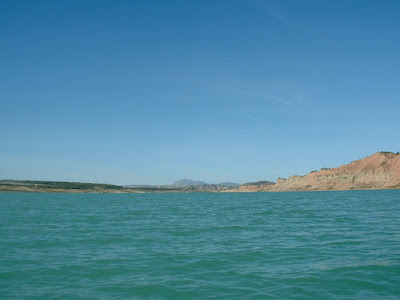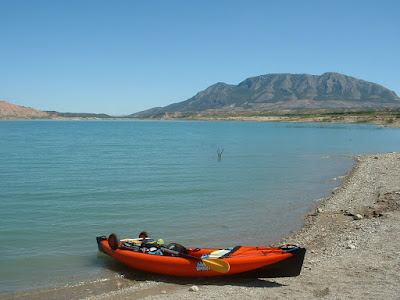Back on the sea:
During the
long and hot summer(very hot and very long), with crowded beaches,
roads and car parks, I had avoided the coast. Embalse de Negratin had
been a more pleasant place for my type of quiet kayaking. My first trip
back to the sea, since May 4th., was on Tuesday November 28th. when I
took The Smart One to Villaricos:
There are
four places at Villaricos where I can get on the water fairly easily
with a kayak. Because of a not entirely favourable weather forecast
I opted for the one close to Chiringuito (beach bar) Las Brisas,
where a reef of rocks, about 25 metres out from the shore, creates a
calm patch between shore and reef in most sea conditions. It doesn't
take much of a 'lift' in the water to make getting afloat on a
'steep-to' beach a bit tricky, without getting wet. Also, at this
particular spot, it's only a short distance across sand from car park
to shore. The Smart One is light enough to carry that far without
faffing around with a kayak trolley,
It wasn't a
perfect morning. I got on the water at 10:15 a.m., when just a light
breeze, off the land, barely ruffled the water, but that wind soon
picked up a little and backed to blow off the sea. A plan for a
longish distance paddle, south along the coast, was abandoned in
favour of a bit of dodging backwards and forwards between the two
marinas at Villaricos. Running one way, with following wind and
waves was very pleasant, punching back again, against those elements, was harder work.
Time on the
water was 2 hrs. and distance paddled was 6.6 km.
To Isla Negra and beyond:
Next trip to
the sea, again with The Smart One, was on December 23rd. Another
commitment kept me home on the Winter Solstice but I was on the
water, at Punta Parda, the following day – the first full day of
winter. Nothing untoward in the weather forecast that day and sea
condition near perfect for a long paddle. Got on the water at 11:00
a.m. and conditions looked so good that I decided on a repeat of my
paddle to Isla Negra (blog post 29/4/23) and, if all went well, to
continue to the headland (Punta Cañón) a bit further on. The town
of San Juan de los Terreros is just around that headland.
Approaching
Isla Negra. The island on the horizon is Islote de San Juan de los
Terreros – a long name for a little island! A circumnavigation of
that island is a future possibility, in the right conditions.
A view of
the old part of San Juan de los Terreros as round Punta Cañón.
Conditions were still very favourable when I reached Isla Negra, and
it hadn't taken as long to get there as I had anticipated, so I had
pressed on.
A nice vista
of San Juan opened up when I cleared Punta Cañón. The old part of
the town on the right of the picture with the sprawl of more recent urbanization,
along the shore, on the left. It was now time to turn back.
Looking back
from Punta Cañón. Conditions still very good, although a breeze
did start to ruffle the water later, when Isla Negra (that dark lump)
was well astern of me.
Back at
Punta Parda, at the entrance to the bay. Not many people on the
beach now, but hidden from view is a motor-home and camper-van city!
Vehicles of all shapes, sizes, ages and conditions, owned by a variety of
nationalities, mainly Northern Europeans, gathered here in
Spain for the winter sun.
Time on the
water this time was 2¼ hrs. and distance paddled was 7.8 km.
It's been a
pretty good year for my quiet kayaking. A record year of 14 trips
plus a new kayak, the Neris Smart 1, to play with. I'm still at two
kayaks. That new kayak, and the possibilities that go with it,
made my little Gumotex Twist 1 redundant – but it has a new good
home, with family, in the U.K. The Twist served me well, for 37 trips over 6 years. .

























